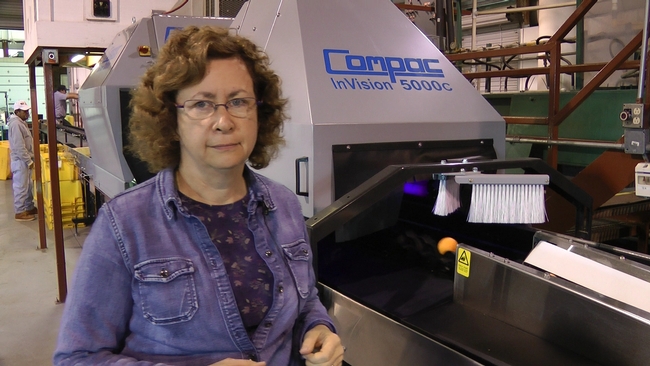High-tech tool helps researchers assess citrus quality
The UC Lindcove Research and Extension Center has a new, state-of-the-art fruit grader, which automatically gathers detailed information on individual citrus fruits for California researchers. The machine provides data that has not been available to Lindcove researchers before.
Typical fruit grading equipment determines fruit size, count and grade. The Compac InVision 5000c has three lighting systems – fluorescent, ultraviolet and near infrared – plus a weigh bridge that together measure fruit dimensions, weight, color, and blemishes from insect damage, scarring and sunburn. Without spoiling the fruit, the grader also determines its sweetness and assesses internal damage. The new line can handle citrus fruit sizes ranging from a small mandarin up to a grapefruit.
“This equipment will give our researchers much more precise information for making comparisons,” said Beth Grafton-Cardwell, director of the Lindcove REC. “Our old packing line could tell us an overall color of the fruit. The Compac grader precisely defines how much of the surface area is green, yellow and orange.”
Highly advanced software works in conjunction with the equipment, recording measurements and a series of photographs – color and ultraviolet – for each individual fruit, allowing scientists to run correlations between all the parameters.
“We can determine which rootstock and scion combinations give the perfect size, sweetest taste and best ripening fruit,” Grafton-Cardwell said. “We will be able to train the software to recognize various types of pest damage – such as damage from katydids and citrus peelminer – and demonstrate which pesticides best protect the fruit from damage.”
In the past, labor costs limited researchers to gathering such detailed information from only a small sample of fruit on certain trees. With the new Compac grader, all the fruit from particular trees can be thoroughly assessed.
Another benefit of the upgraded equipment is its light-touch. The machine can gather data about mandarin oranges without harming the delicate peel. Growing interest in mandarins has UC scientists devoting more time and resources to the diminutive fruit. While Valencia and navel orange acreage is holding steady or dropping in California, mandarin acreage has tripled in the last 10 years.
“As the Valencia market has declined, many Valencia orchards are being replaced with mandarins,” Grafton-Cardwell said. “We have dozens of excellent varieties of mandarins and consumers love them because they’re easy to peel. Mandarins are the wave of the future.”
The cost of the Compac fruit grader was covered by the Citrus Research Board, a grower-funded organization created to support citrus research.
“The new fruit grader is another example of the excellent collaborative relationship the University has with the citrus industry,” Grafton-Cardwell said.
See the components of the new fruit grading system in the video below:
Compac2

